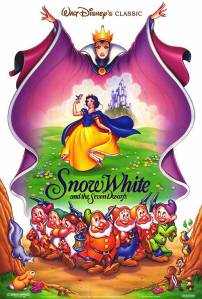By GJ Brodbeck
The year is 1934, and Walt Disney is looking ahead from his perch as the main visionary of animated short films of the day. He comes up with an ambitious and financially risky plan: a full-length animated feature film. Over the course of three years, Disney and his animators work day and night to make a film that many in Hollywood derisively called “Disney’s Folly.” Little did they know that over 80 years later, Snow White and the Seven Dwarfs is still considered not just one of the greatest animated films of all time, but one of the greatest films of all time, period.
Taken from the Grimm Brothers’ fairy tale, the story is familiar to almost everyone. An evil queen wants to be “fairest in the land” but finds there’s one young woman in the way: The princess, Snow White. So the Queen sends a huntsman to kill Snow White, but he chickens out and instead sends Snow White to hide in the forest. The Princess then comes across a cottage where the seven dwarves live. The Queen finds out that Snow White is still alive, and transforms herself into a hag to get rid of her rival. Snow White gets saved in the end, of course, the Queen dies, and everybody lives happily ever after.
What’s new and dangerous in the Disney version is how it looks, especially in today’s animation world. The backgrounds and settings are mostly bright and colorful, but they can also be dark and creepy. The forest scene was probably the riskiest move to take in this early animated film, as some of the imagery presages the forest scenes in The Evil Dead, giving off an intimidating vibe. It showed that animation could be directed towards adults who would appreciate this kind of artistry, as opposed to the film being just for kids.
How the film looks is one thing, but the content of the film still shines as a benchmark in the modern world of animation. The jokes still work today, as a fair chunk of them are physical comedy as opposed to wordplay. All of the dialogue spoken in the film could still be said today and make perfect sense. The music fits the picture perfectly, and the songs, from the wacky “Silly Song” to the serene “Someday My Prince Will Come,” are ones that people still remember to this day for good reason.
Snow White (voiced by Adriana Caselotti) is considered one of the weaker Disney princesses; she doesn’t do much, and is just there to be a pretty face. To be fair, she is more engaging than the Prince (who has no name), whose limited input comes mostly in song. The dwarves are everybody’s favorite characters, and Grumpy and Dopey have risen in prominence over the years. Their scenes show a lot of depth, both in drama and comedy — take, for example, the scene where Dopey accidentally swallows a bar of soap while the others hold down and wash Grumpy. The Queen (voiced by Lucille la Verne) is not an interesting villain, just a really vain woman. What keeps people flocking to her as a character is her demeanor and her animation, both before and after her transformation, especially in the movie’s climax.
But does Snow White still work in today’s animation scene? Much like The Wizard of Oz or Where The Wild Things Are, Snow White is a movie fuelled primarily by emotion. The movie gives you what your emotions want; it brings viewers back because it reminds them of the first time that they saw it and stays true to the fairy tale. And, like fairy tales in general, the film still works today because it tells a story to help people in real life as well as entertain them. That is what Disney wanted to bring to the story, and this still stands as one of his greatest achievements.

You must be logged in to post a comment.